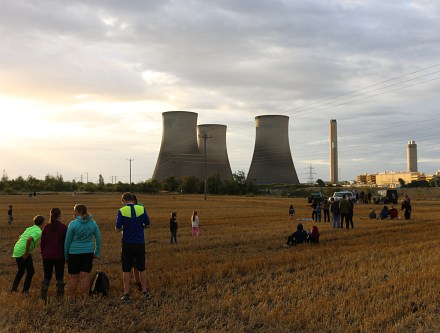
The fields between Sutton Courtney and Didcot Power Station attracted crowds to view the demolition of the final three cooling towers.
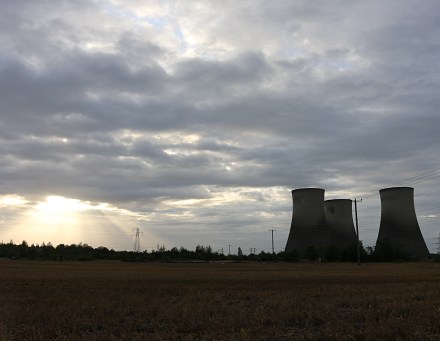
People had gathered from before 6 am as the expected explosion and demolition was to be between 6 am – 8 am. Then just before 7 am there was a siren, and one chap sent up a drone to get an aerial view.
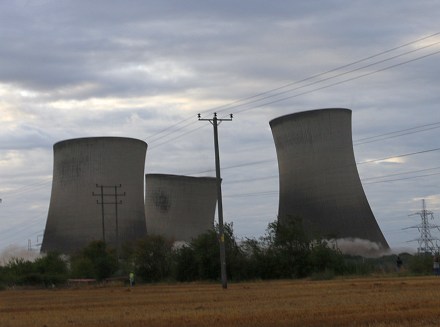
At 7 am there was an explosion and the towers began to fall to the ground.
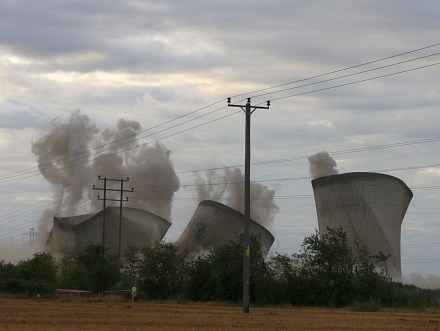
It only took a few seconds
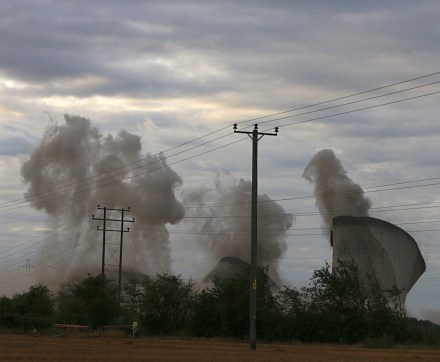
for all three to collapse.
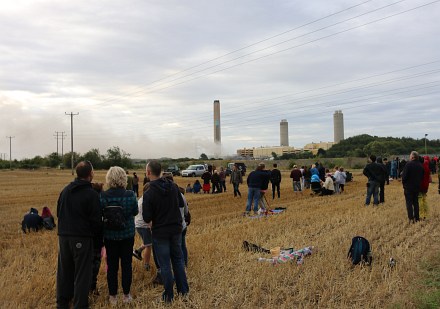
There was a cheer from the crowds when they were all down.
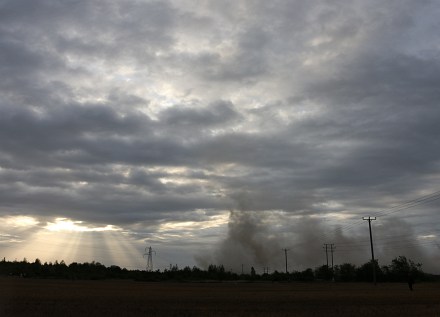
People started to head off as the clouds of dust cleared.
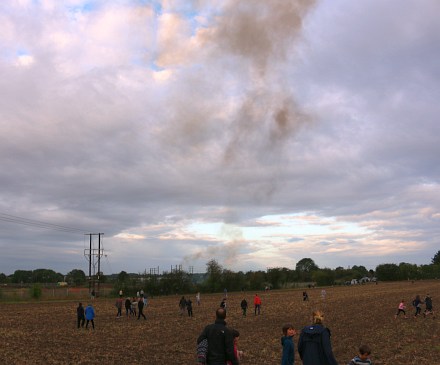
I heard screams and saw a yellow flash in the field behind us. Through a hedge I could see what looked like bright lights chasing people. There were rumours of a transmission explosion.
At about 7 am, there were power cuts back in Abingdon for a short while.
wondered what caused the power cut here in Abingdon – now to reset all the clocks!!
These landmarks for so many years will be missed, always a sign that we were nearing home.
It is extraordinary that with all the planning that must have been in place there was such an impact on the electricity supply.
Where was Fred Dibnah when we wanted him? Nobody seems to have understood and learned from his extraordinary skill (and that of other steeplejacks) in bring towers like these down without recourse to explosives and the paraphernalia that takes control away from the event.
Is it beyond the wit of our engineers and scientists to devise clean coal-fired power stations? Don’t we need a mix of technologies rather than putting all our eggs in one basket?
Please explain without being abusive 😉
where was fred dibnah? – try six feet under.
They were a great landmark. One knew that we were not far from home once the towers came into view.
Pjs asked three questions. For the first, it is hard to see why bringing down the cooling towers of a defunct power station would in any way affect the local electricity supply.
Re the amazing Fred Dibnah, he brought down vertical brick built chimneys – very different structures compared to the massive concrete cooling towers.
As for ‘clean’ coal fired power stations, some things really are impossible. One could add Going to Mars and Fusion energy to that list.
Finally, I think our energy does from a reasonable technology mix.
Hedley,, only post when sober.
Thanks for a clear explanation, Hedley.
Newcomer, why two commas? We all make mistakes.
ppjs, you’re unfamiliar with the grammatical ‘Oxford Stutiter’ … how remiss.
I’ve not had a good ‘Bing’ so can’t be sure of any facts – whether true or false, but I’d imagine ‘clean’ power is relative to your argument and how hard you might choose to look …
We conveniently ignore what raping of the environment occurs to satiate our ‘clean battery’ technology, or carbon footprint of wind turbine manufacturing…etc etc…
Daniel, I agree; that lass crossing the Atlantic in an attempt to go green is using a yacht with a far higher carbon footprint per person than she would have made flying in a jumbo jet.
We need good hard science to back up our noble aspirations.
Dear PPJS,
“We need good science to back up our Noble aspirations.”
Can you please provide numbers to support your statement that the yacht trip has a far higher carbon footprint that a flight?
The power cuts were due to the dust from the demolition reducing the phase clearance between two or all three phases of the high voltage cables close to the towers.
The reduced clearance induced a two or three phase fault, this in turn took out what ever was mounted on the pole in the field . Either a piece of switchgear or a transformer.
Lovely to see clear sky this morning around Didcot.
Once the chimneys are gone, a long chapter draws to a close and the town will move on with much-needed expansion of new housing and industry.
Happy days.
The aviation sector accounts for 2% of annual global greenhouse-gas emissions. A 747 aircraft emits more than 21 pounds of carbon dioxide into the atmosphere per mile travelled.
21 lbs is 9534gms; an Airbus carries a maximum of 853 passengers. Let us assume a 75% seat occupancy; that is 639 passengers. This results in 14.92 gms of CO2 emissions per passenger mile. The flight distance from London to New York is 3470 miles. One passenger therefore emits 51773 gms (114lbs; just over a hundredweight).
That is a nasty sum and so anything we can do to reduce that is going to be beneficial.
However, Miss Thunberg’s trip involves the flight of two team members to New York to bring the yacht back.
That is 103456 gms (2 cwt) of CO2 emissions to get the yacht back across the Atlantic.
So, before we begin to add in the emission produced in manufacturing the plastics used in making the yacht, we have twice the emissions that Miss Thunberg would have produced if she had simply got on a plane.
The leading French sailing magazine Voiles et Voiliers has recently asked the heads of Multiplast boatyard and CDK Technologies about the environmental impact when building an IMOCA 60. To build this type of race boat, 3 tons of carbon fibre, moulds for hull and deck, a number of construction materials and various resins (baked at 120° during the construction process) are needed.
Of course, the more a yacht or a plane is used the more carbon-efficient its initial production becomes. However, more jumbo jets are built than super-efficient yachts and no yacht at present carries 600+ passengers per trip.
Ms Thunberg is right to draw our attention to carbon emissions, but she also acknowledges that most people will not have a couple of weeks free for each transatlantic trip. The economics suggest that a single-issue approach is not viable in time, energy or money.
Of course, there are further issues and ramifications, but that’s why we need some more hard science!
Interesting that the overseas owners of Didcot were happy to shut it down and flatten it, but for example Germany plans to keep open its coal fired power stations for at least another 20 years. On the one hand I’m glad to have a clear view across to Didcot again, but I’m sad to see the destruction of one of the best designed and planned power stations. Moreover with no deep coal mining left in the UK we should really worry that we are now no longer self sufficient for energy. The reason for the demolition is not about science, it is about economic and political power, and control.
The EU has mandated clean air requirements, which can’t apply to Germany, given its coal-fired power station programme.
It’s almost as though the EU is designed to make countries massively dependent on each other to ensure none can ever step out of line.
I was in Sicily two weeks when Google hosted a conference on climate change but only the rich and famous were invited! Prince Harry flew in by private jet then took a helicopter to the venue after which he stayed on a luxury yacht before taking his private jet home! A week later he took another private jet to his mates Elton Johns pad in Nice, but that was excused as being carbon neutral because EJ paid to off set the damage to the environment by buying carbon credits! One rule for the rich (and Germany) and another for the rest of us – eh?